
by Jessica Hughes | Mar 21, 2023 | Main Articles
by Jessica Hughes


The Glendale rugby team, American Raptors, has returned to the U.S. to continue its season at Infinity Park Stadium in Glendale.
When the Colorado Raptors withdrew from Major League Rugby back in April 2020, the direction of the team was unknown. Now, as of fall 2021, the Raptors brand returned after the club announced the decision to transition from the Colorado XOs to the American Raptors.
The American Raptors is a team of cross-over athletes from all different athletic backgrounds learning to play the sport of rugby. The intention for creating this team is to help build out a talent pool of American rugby players that can eventually be recruited to play American rugby in the U.S.A. Rugby World Cup.
But not just anyone can join. General Manager Peter Pasque runs a sort of boots-on-the-ground campaign recruiting a pipeline of non-traditional rugby players from across the nation. The invite-only roster has seen some success stories with athletes such as David Still, who played college football and joined the Colorado XOs team for eight months and will now play in the 2024 Olympic rugby team.
This will be the first season the American Raptors will play in the Super Rugby Americas League, which officially launched in 2019 as SLAR. The competition is made up of seven franchises focused on the development of rugby players. The league is made entirely of teams from South America, with the American Raptors as the only team from North America. Other firsts to join this year in the competition include two franchises from Argentina, and one each from Brazil, Chile, Paraguay, and Uruguay. Colombian players will also participate in the continental tournament.
The league competition began February 18, 2023, and will conclude June 9. The Raptors split their time between playing in South America — where they have been the last two months — and at Glendale’s Infinity Park.
Their home opener concluded March 24 against Dogos, with five more home matches lined up, before ending the season in South America. If they advance, the post-season will take pla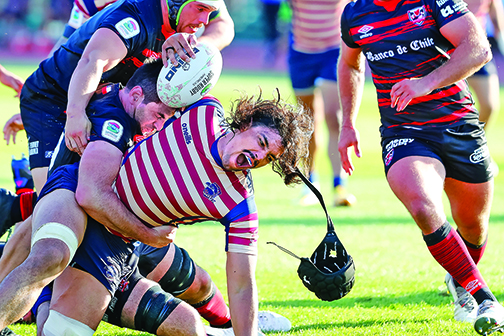 ce the first two weeks of June with the final match played in Uraguay.
ce the first two weeks of June with the final match played in Uraguay.
Infinity Park is a fun venue to enjoy the fast-paced game of rugby. Come out and see some big hits, meet the players, and support the Raptors. Tickets are $10 and children 12 and under are free.
For more about the American Raptors visit them at americanraptors.com or on social media, @Ameri canRaptors. Games are broadcast on ESPN+.
Photos by Sebastian Miranda of Gaspafotos

by Jessica Hughes | Feb 22, 2023 | General Featured
by Jessica Hughes

Virga by Patrick Marold. Photo by Rudi Cerri
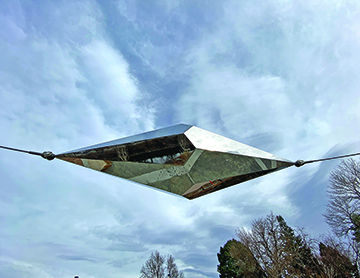
Infinite Span by Michael Buckley. Photo provided by denverpublicart.org
With more than 400 pieces in the Denver Public Art Collection and more than $40 million funding into new public art commissions, the City and County of Denver is dedicated to its public art program.
The collection includes traditional art forms such as sculpture and painting, but also includes sound art, projection and light-based works, interactive new media pieces, temporary fiber-based works, and performance-based works.
The program was established in 1988 as an Executive Order under Mayor Federico Peña. The order states that 1% of any capital improvement project over $1 million undertaken by the City, be set aside for public art. Additional funding comes from the Urban Arts Fund, a graffiti prevention and youth development program, focusing on community-building and social change.
Over the past 30 years these commissioned artworks, along with historic and donated works, make up Denver’s Public Art Collection.
As we spring forward into war
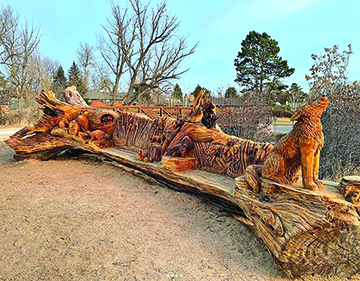
Cottonwood Critters by Chainsaw Mama. Photo by JLH in DESIGN
mer days, it’s a great time to discover some of Denver’s public art that can be found along its most popular trails. So, hit the trail and immerse yourself in nature and the arts with these notable stops.
Cherry Creek Trail
From Confluence Park to Cherry Creek Reservoir, use the Cherry Creek Trail Tour to find these and other artful stops along the 11 mile stretch of Cherry Creek in Denver.
A favorite piece along the trail is the Virga by artist Patrick Marold. The piece sits atop the Delgany St. Bridge over the trail. Made of over 300 stainless steel tubes, suspended in the structural steel, the architectural sculpture was inspired by the cycle of water in Colorado and is intended to eventually support the growing vines on the west end of the bridge. Blending art with nature, the installation may become a living canopy over the bridge.
Located at Confluence Park at Shoemaker Plaza, Sing and Glide by artist Jeanne Quinn, is a mosaic sculpture using the colors of the sea to mimic the flow of the river that cuts through the urban park. “Confluence Park brings together two rivers, the South Platte and Cherry Creek. It is also an urban park, a place where nature and city life are married,” the artist, Jeanne Quinn said in a statement about her work.
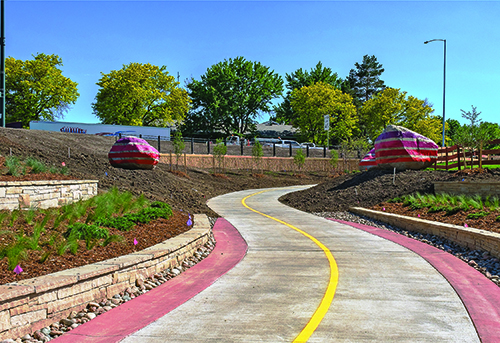
We Are Future Strata by Michael Buckley. Photo provided by High Line Canal Conservancy
Created by artist John King, Talk to the Birds, is a 16’ mild steel kinetic sculpture. Located in the Hampden neighborhood, the artwork is installed in a grassy section formed by the junction of the Cherry Creek Trail and the spur trails from South Havana Street. The goal of this artwork is to celebrate the community, uniqueness, and diversity of the students at the Joe Shoemaker School.
High Line Canal
From Waterton Canyon to Green Valley Ranch, just south of Denver International Airport, the High Line Canal runs 71 miles long, divided into two main areas — the northern and southern half. “In general, the northern half of the canal trail is paved and it’s where people will find more public art pieces,” says Suzanna Fry Jones, Senior Director of Programs and Partnerships at the High Line Canal Conservancy.
“A focus for us is to see how we can enhance the trail but not interfere with the natural scenery around it,” says Jones. A perfect example of that is the artwork found at the corner of Hampden and Colorado (mile 37). Titled, We Are Future Strata, the cluster of three 50,000-pound granite boulders are painted with brightly colored stripes meant to depict strata. Local artist, Michael Buckley, wanted to convey a post-human future where the man-made environment has become strata stone.
The art found along the trail system is a mix of commissioned pieces by the Denver Public Art program and community artists adding to public spaces. “In fact, much of the art pieces found along the trail happened organically from the locals in the community,” says Jones.
Some of these pieces include Ceramic Birds, artist unknown, located in Centennial near mile 29. Other pieces include unique wood carvings by Loveland artist known as Chainsaw Mama. There are two at Bible Park, near mile 41 and 42, plus the third sculpture, Cottonwood Critters, a bench near I-25 and mile 39.
To learn more about the High Line Canal Trail and what to see use their online guidebook.
South Platte River Trail
With the improvements made over the years along the South Platte River Trail, public art has been added in a few spots to help with its beautification. One piece of note is Infinite Span, by artist Michael Buckley.
Located at the Grant-Frontier Park, in the Overland neighborhood, the piece is a mirror-polished stainless-steel diamond suspended by stainless steel cables. Floating over Grant Frontier Park, the artwork is meant to represent the infinite nature of time and the fleeting present moment.
To build your own Denver Public Art Tour visit them at DenverPublicArt.org or use one of theirs highlighting certain areas and themes. They also host guided tours with the summer schedule coming out soon.
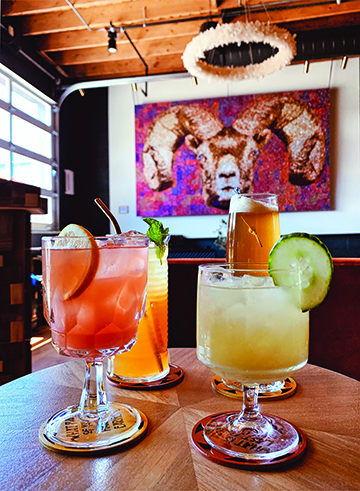
by Jessica Hughes | Dec 16, 2022 | Main Articles
by Jessica Hughes
As we all look to the new year with fresh intentions and a goal-oriented mindset, one new year resolution that has become popular over the years is Dry January. A health campaign that started in 2013, Dry January is a way to begin the new year with healthy habits and a clear mind by removing alcohol consumption for the entire month.
Whether you need a break from drinking after the holidays, kick-start a healthier routine, or have always preferred not to drink, achieve your goals without feeling deprived, with curated mocktail menus from these local Denver bars.
Honey Elixir Bar

Non-alcoholic potions that tend to the body and mind, from Honey Elixir Bar. Photo courtesy of Honey Elixir Bar Facebook
Where: 2636 Walnut St. #104, Denver, CO 80205
Encouraging rejuvenation over depletion, Honey Elixir Bar is a drinking experience that is meant to reinvigorate and stimulate, not tear down. Their chic mocktails and cocktails are met with equally chic interiors of their funky lux lounge where sipping has become a lost art form. You won’t find any imitations of well-known cocktails, as their mocktail menu is truly original with favorites like the Chocolit and the Mai Chai.
The cornerstone of their elixir bar is the fermented drink, Jun. Similar to kombucha, Jun uses honey and green tea instead of black tea and cane sugar. Honey has partnered with two local master brewers of Jun, Ish’s Brew and Ling Elixirs (both based in Boulder) to offer this healthy alternative as the basis for many of their mocktails. Do note, Jun does naturally contain 3-4% alcohol.
For truly non-alcoholic drinks, sip and savor their natural cacao or shift your consciousness with invigorating drink potions infused with botanicals, herbs, and super foods. Even their cocktails are made with high-quality spirits, honey instead of sugar, and high-quality botanicals, so no need to feel guilty with these alcoholic drinks.

An artful cocktail bar paired with crafty mocktails at Room for Milly. Photo courtesy of Room for Milly Facebook
Room For Milly
Where: 1615 Platte St., Suite 145, Denver, CO 80202
With a nod to travel and an ultra-modern-chic atmosphere, Room for Milly is designed to be a place for friends to gather over a good conversation, admire an artful interior, and enjoy a good cocktail. Along with their beer, wine, and sake menu, the bar also features a tantalizing list of zero-proof beverages. The select group of three include: the Cantab, a jasmine iced tea with umb shrub and pomegranate; the Clara with seedlip spice, tonic; and the Avenue No. 3 with seedlip spice, ginger, jasmine tea, honey, and citrus.
Forget me Not
Where: 227 Clayton St., Denver, CO 80206
Located in the heart of Cherry Creek, Forget Me Not is a cocktail bar that infuses the art of decor, sophistication, and color in both its drinks and its interiors. Placed in the middle of their large cocktail menu are three delightful zero-proof drinks that won’t make you miss the liquor. Choose from the Perfect Vision with seedlip grove, coconut water, verjus, rose water; the Deep Roots with seedlip garden, tarragon, beet, ginger, citrus stappi red bitter; and the Green Machine with seedlip grove, cucumber, salted lemon, and ginger.
Lady Jane
Where: 2021 W. 32nd Ave., Denver, CO 80211
Located in the trendy LoHi neighborhood, Lady Jane is an unpretentious cocktail bar that makes serving
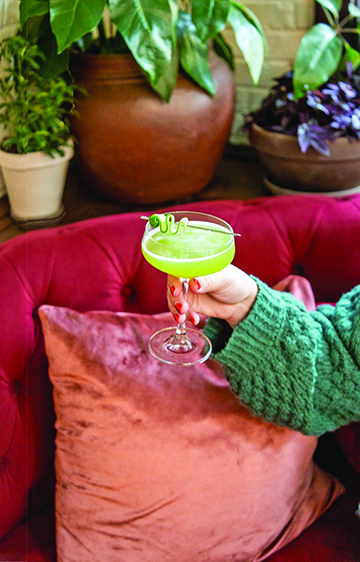
Forget Me Not’s Green Machine made with seedlip, cucumber, and salted lemon. Photo courtesy of Forget Me Not Facebook
delicious drinks look easy. On their menu, are four mocktails that do anything but mock other cocktails. With four original drinks, including a pomegranate-ginger spritz, a spiced apple sour, coffee colada, and a pink guava cooler. While you will find more cocktails than mocktails on the menu, even their alcoholic drinks serve up fresh local ingredients with high-end spirits to minimize the guilt factor.
Death & Co.
Where: 1280 25th St., Denver, CO 80205
Don’t despair, even the most sought-after cocktail lounge, Death & Co. is home to a surprisingly decent list of mocktails and non-alcoholic drinks. The swanky RiNo location invites cocktail and mocktail purveyors alike, with the carefully curated zero-proof drink selection. Choose from three different options: the Alpenglow with hibiscus, black tea, bay leaf, lime, and seltzer; the Holidays in the Sun with non-alcoholic dry Aperitif, Moroccan mint tea; and Out of Time with Three Spirits Livener, blueberry, cold brew, and coconut. In addition to their mocktails, they also offer a brief selection of non-alcoholic beer and wine.
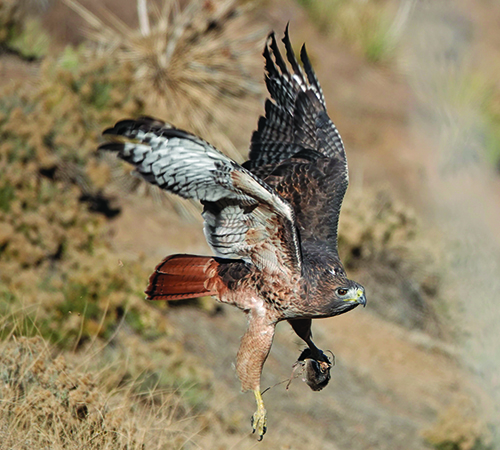
by Jessica Hughes | Dec 16, 2022 | General Featured
by Jessica Hughes

Bird walk leaders at Bluff Lake Nature Center. Pictured from left to right: Jason Bidgood, George Ho, Steve Hebert, and Lisa Pera.
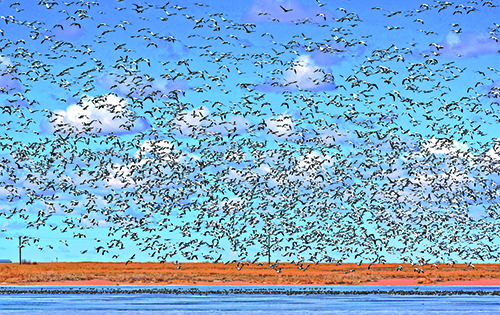
Thousands of snow geese flock to the reservoirs and farmland of the Eastern Plains. Photo by Jessica Hughes
Colorado is home to over 400 species of birds that either live here year-round or pass through during seasonal migrations. But when is the best time to see them? While most think of birding during warm-weather months, birdwatching is a year-round activity, with winter being one of the best times for viewing.
“Colorado winters are full of sunny, mild days which allow birders to enjoy the outdoors. Plus, the lack of leaves on the trees allows for better viewing of the birds,” says George Ho, Bluff Lake Nature Center Bird Volunteer/Monthly Bird Walk Leader. “Winter is great for birding.”
“There are plenty of ducks, geese, and raptors that migrate south to our parks and lakes to spend the winter in our (relatively) warm climate,” says Ben Jacques, Bluff Lake Nature Center Outdoor Explorers Program Coordinator. Also, since they must keep their bodies warm, they spend a lot of time moving around searching for food. This makes them easier to spot and hear through the bare foliage.”
“Plus, with shorter sunlight hours, good winter birding doesn’t require a 4 a.m. alarm,” says Jacques.
So, what should you expect to see? From the admired bald eagle to song sparrows, there is a variety of winter fowl to catch your eye. “Bald eagles are more plentiful in the winter here in Colorado because they come south to us from the north. Waterfowls like ducks are abundant in winter as well,” says Ho. “Winter sparrows are also popular to see. These include the white-crown sparrows and the juncos as well as the year-round song sparrows.”
He also says birds of prey are abundant, including owls like the great horned owls, hawks like the ferruginous, and the year-round red-tailed hawks, plus falcons like the prairie falcons and the American kestrels.
The best part is you don’t have to travel too far to see these beautiful birds in flight. Below are a few places close to home that make a great afternoon outing or a fun family day trip.
Bluff Lake Nature Center
Within Denver’s city limits, Bluff Lake Nature

A Red Tail Hawk swooping in on its prey. Photo by George Ho at Bluff Lake Nature Center
Center is one of the best places for birdwatching in Denver. The 123-acre nature preserve has spotted 226 different species of birds according to their active community of birders who record their encounters.
For the beginners and families, the center offers bird walks throughout the year. Led by an expert guide, discover how and where to spot certain birds and learn about the different species you can find in Colorado. The walks are free, but you need to sign up in advance on their website. Download their printable birds of Bluff Lake checklist and keep track of what you spot.
Visit their birding page to learn more at www.blufflake.org/birdwatching
Cherry Creek State Park
Cherry Creek State Park is one of Colorado’s most popular parks due to its plethora of summer activities, but most may not think of it as a top birding spot. There are plenty of birds you can see year-round but in winter, soaring bald eagles perch high in cottonwood trees, while gulls meet around the marina and swim beach area. The reservoir eco-system also attracts raptors species including golden eagle, red-tailed hawk, northern harrier, and ferruginous hawk. Because the reservoir typically remains un-frozen throughout the winter, waterfowl and shorebirds are popular to see as well.
Barr Lake State Park
With more than 350 species of birds spotted, Barr Lake State Park is the metro area’s premier birding lake. About 30 miles northeast of Denver, Barr Lake offers one of the best set-ups for winter birdwatching. Walk the 8.8-mile trail that circles the lake, with several wildlife viewing stations and the wildlife refuge at the southern end of the lake. The lake’s large number of bald eagles, including a pair that nests there every year, are what draw in the birding crowds, both amateurs and experts.
Eastern Plains
Beyond Denver and the Front Range, the Eastern Plains create the ideal environment for bird watching in Colorado. The High Prairie and surrounding areas welcome over 40

The Red-winged Blackbird is just one of many birds to spot this winter. Photo by Lisa Pera
0 species of birds including warblers, snow geese, grosbeaks, mountain plovers, and buntings. They make their homes amongst the grasslands, craggy outcrops, isolated ponds and reservoirs, plus rivers lined with cottonwoods and willows. There are 20 birding trails on the Eastern Plains featuring a variety of sites where you can view wildlife.
One of the most significant annual migrations in the state is the Snow Goose migration. Every winter, in January and February, the wind-swept plains and open-water reservoirs near Lamar, Colo., turn white, not with snow, but a swirl of 200,000+ snow geese descending upon the High Plains of Colorado. By way of the Western Central Flyway, the annual migration lasts up to two weeks and can be seen within state wildlife areas, local reservoirs, and area farms where they stop to feed.
High Plains Snow Goose Festival
In celebration of this migration, Lamar County hosts the annual High Plains Snow Goose Festival, taking place Feb. 3-5, 2023. As one of the largest birding festivals in Colorado, the event hosts a variety of programs, tours, and seminars that highlight the area’s landscape and unique birding heritage. Sign up for birding tours, shop the local craft fair, and listen to lectures to learn more about the migration and other local fowl. The event is free but tours and lectures require an advanced purchased ticket. For more information visit highplains snowgoose.com.
Birding Tips
The bird walk leaders at Bluff Lake Nature center say the best time to see birds is when they are most active, at dawn and dusk, when they are feeding. Patience and a good pair of binoculars are essential to get the most out of bird watching. “Plan your bird watching around a bird’s basic survival needs (food, water, and shelter) and you’re bound to get some birds in your binoculars,” says Jacques.
Jacques also suggests if you are new to birdwatching there are many beginner-friendly groups around Denver to join. The Denver Field Ornithologists, Denver Audubon, Bluff Lake Nature Center, Tuesday Birders, and multiple bird feeding stores run free bird walks in the area. Or download the free Merlin bird ID app by Cornell Lab for a great field guide on your phone.
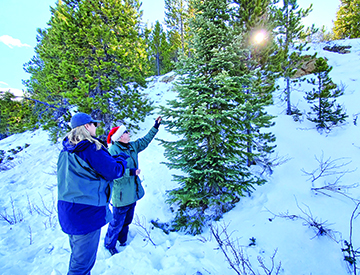
by Jessica Hughes | Nov 17, 2022 | Travel
by Jessica Hughes

Local tree cutters assess the perfect Christmas tree.
For many Coloradans, cutting down their own Christmas tree has become a time-honored tradition over the years. It is not only a favorite holiday activity for families to enjoy together, but it’s economical and you can take pride in knowing you’ve played an active role in managing your national forests.
Dating back to the 1930s when the Christmas tree was defined as “a tree displaying a short internode combined with a symmetry of form that is pleasing to the eye,” according to a 1930 Eldorado National Forest report on cutting Christmas trees. Since then, the National Forest Service has played an important role over the years in the business of Christmas trees, including harvesting, selling, and permitting the cutting of trees.
So, how does it work exactly? The U.S. Forest Service allows the cutting of trees in certain districts throughout Colorado with the purchase of a permit. There are several Forest Service cutting areas near and along the Front Range, with each district regulating its permit system a little differently.
Permit holders are responsible for understanding where it is legal to cut a tree and should spend some time reviewing the information and maps provided on the Forests’ webpage. While you can purchase your permit at designated ranger district offices or at some local vendors, the best and easiest is to purchase your permit online at recreation.gov.
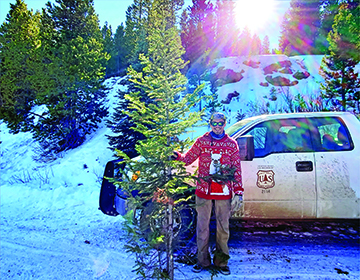 The Denver/Front Range Christmas Tree Cutting areas include the Arapaho & Roosevelt National Forests, Pike National Forest, and the White River National Forest. Each is broken out down below:
The Denver/Front Range Christmas Tree Cutting areas include the Arapaho & Roosevelt National Forests, Pike National Forest, and the White River National Forest. Each is broken out down below:
Denver/Front Range Christmas
Tree Cutting area Forest Offices:
Pike and San Isabel
National Forests
South Platte Ranger District
(Buffalo Creek)
303-275-5610
The South Platte Ranger District is closest to Denver. Permits in this district apply to specific cutting areas (Buffalo Creek, Sugar Creek, and Camp Fickes) and specific dates for cutting. Permits are limited and may sell out.
Permits: $20 per tree
Cutting dates: Nov. 25 – Dec. 11
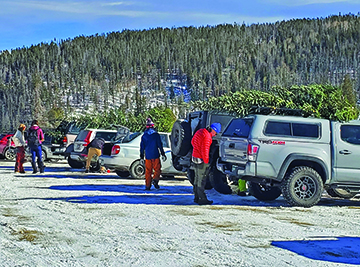
Tree cutters line up with their cars to haul off their hand-picked Christmas trees.
South Park Ranger District
Fairplay, CO 80440
719-836-2031
The South Park Ranger District is closest to the towns of Fairplay, Jefferson, Como, and Lake George along Hwy. 285. This area is another great option for Front Rangers and those living in the Denver metro area. Most of the district is open for cutting. Unlike the South Platte District, there is no tree quota, so permits will not sell out.
Permits: $20 per tree
Cutting dates: Oct. 13 – Dec. 31
Pikes Peak Ranger District
Colorado Springs, CO
719-636-1602
The Pikes Peak Ranger District is closest to Colorado Springs with specific cutting areas near Woodland Park. There is not a limit on permits, so no need to worry about selling out.
Permits: $20 per tree
Cutting dates: Nov. 25 – Dec. 18
Leadville Ranger District
Leadville, CO 80461
719-486-0749
The Leadville Ranger District is closest to the town of Leadville with most of the area open for cutting. Again, there is no quota, so permits won’t sell out.
Permits: $10 per tree
Cutting dates: Nov. 10 – Dec. 31
San Carlos Ranger District
Canon City, CO 81212
719-269-8500
The closest towns the San Carlos Ranger District serves are Canon City, Westcliffe, and La Veta. Most of the area is open for cutting and permits will not sell out.
Permits: $10 per tree
Cutting dates: Nov. 10 – Dec. 31
Salida Ranger District
Salida, CO 81201
719-539-3591
The Salida Ranger District serves the nearby towns of Salida and Buena Vista. Most of the district is open for cutting. There is not a quota, so permits will not sell out.
Permits: $10 per tree
Cutting dates: Nov. 10 – Dec. 31
Arapaho and Roosevelt National Forests
Permits to cut your own Christmas tree on the Arapaho and Roosevelt National Forests are on sale now on recreation.gov and remain available through January 7. Permits must be purchased in advance and cost $20 each.
Sulphur Ranger District
Granby, CO 80446
970-887-4100
For other Christmas tree cutting area forest offices throughout the state visit fs .usda.gov.
The Forest Service recommends downloading forest service maps onto your phone through Avenza before heading out. This app works even when there isn’t cell service and will help you make sure you don’t cut trees on private property or prohibited areas. Most roads will be closed to motor vehicles after Nov. 15, but snowmobiles or skis may be used to access some areas. Make sure the Forest Service Road you plan to drive is open using our Road Status Tables.
For more tips on what to bring, how to plan your trip, and helpful cutting tips be sure to visit recreation.gov/tree-permits.
Photos taken by Cora Marrama. All images were provided by the Arapaho and Roosevelt National Forest

 ce the first two weeks of June with the final match played in Uraguay.
ce the first two weeks of June with the final match played in Uraguay.














